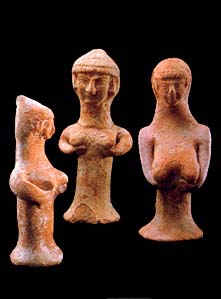Image Details

Israel Museum
Lovely ladies. Most of the figurines discovered from Judah are of females; of the many types, the most common is the pillar figurine. About 5 or 6 inches tall, the body is solid and shaped like a column, while the head was made separately. These figurines are usually identified as representations of Astarte, the fertility goddess, because of the exaggerated breasts that the goddess supports with her hands. Other, less common, styles include figurines with a bell-shaped body, those with “bird’s” heads and those made from a mold, sometimes wearing a necklace. Male figurines in Judahite culture, on the other hand, only came in two types: wearing a turban or riding a horse (see photograph). The latter is the most common, and, Stern suggests, probably represents a warrior god.
The plethora of figurines, cult stands and temples illustrating this article is in marked contrast to Israelite religion after the Babylonian Exile in the sixth century B.C.E. From the post-Exilic period we have not a single cult figurine and the only temples to Yahweh are the Second Temple in Jerusalem and its Samaritan competitor on Mt. Gerizim. The Jews, Stern concludes, had removed cultic elements and purified their worship.
